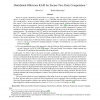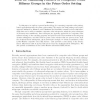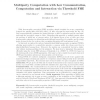118
click to vote
IACR
2011
14 years 19 days ago
2011
Secure two-party computation protocol allows two players, Alice with secret input x and Bob with secret input y, to jointly execute an arbitrary program π(x, y) such that only th...
106
click to vote
IACR
2011
14 years 19 days ago
2011
We present the hash-based signature scheme XMSS. It is the first provably (forward) secure and practical signature scheme with minimal security requirements: a pseudorandom and a ...
67
Voted
IACR
2011
14 years 19 days ago
2011
113
Voted
IACR
2011
14 years 19 days ago
2011
We present a generic transformation that allows us to use a large class of pairing-based signatures to construct schemes for signing group elements in a structure preserving way. A...
121
Voted
IACR
2011
14 years 19 days ago
2011
We put forward a generalization of lossy trapdoor functions (LTFs). Namely, all-but-many lossy trapdoor functions (ABM-LTFs) are LTFs that are parametrized with tags. Each tag can...
IACR
2011
14 years 19 days ago
2011
In the last several years, micro-blogging Online Social Networks (OSNs), such as Twitter, have taken the world by storm, now boasting over 100 million subscribers. As an unparalle...
118
click to vote
IACR
2011
14 years 19 days ago
2011
—This paper proposes a novel fault-propagation pattern based differential fault analysis method - FPP-DFA, and proves its feasibility on SPN structure block ciphers using bitwise...
IACR
2011
14 years 19 days ago
2011
In this paper, we explore a general methodology for converting composite order pairingbased cryptosystems into the prime order setting. We employ the dual pairing vector space app...
111
Voted
IACR
2011
14 years 19 days ago
2011
The wild McEliece cryptosystem uses wild Goppa codes over finite fields to achieve smaller public key sizes compared to the original McEliece cryptosystem at the same level of se...
144
Voted
IACR
2011
14 years 19 days ago
2011
Fully homomorphic encryption (FHE) provides a simple template for secure computation between two parties (Alice and Bob) where: (I) Alice encrypts her input under her key, (II) Bo...




